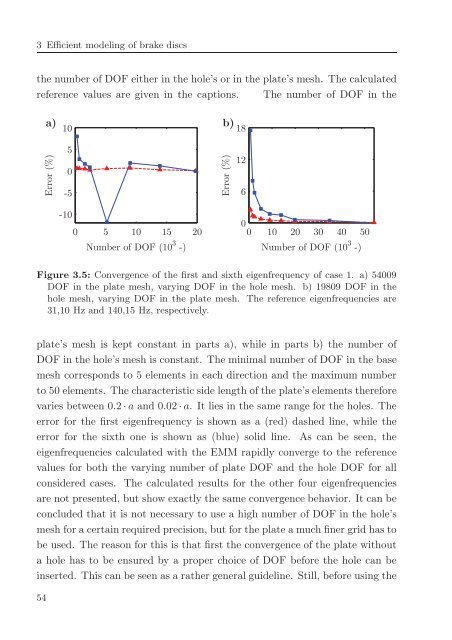Avoidance of brake squeal by a separation of the brake ... - tuprints
Avoidance of brake squeal by a separation of the brake ... - tuprints
Avoidance of brake squeal by a separation of the brake ... - tuprints
You also want an ePaper? Increase the reach of your titles
YUMPU automatically turns print PDFs into web optimized ePapers that Google loves.
3 Efficient modeling <strong>of</strong> <strong>brake</strong> discs<br />
<strong>the</strong> number <strong>of</strong> DOF ei<strong>the</strong>r in <strong>the</strong> hole’s or in <strong>the</strong> plate’s mesh. The calculated<br />
reference values are given in <strong>the</strong> captions. The number <strong>of</strong> DOF in <strong>the</strong><br />
a)<br />
<br />
b)<br />
<br />
<br />
<br />
<br />
<br />
<br />
<br />
<br />
<br />
<br />
<br />
<br />
<br />
<br />
Figure 3.5: Convergence <strong>of</strong> <strong>the</strong> first and sixth eigenfrequency <strong>of</strong> case 1. a) 54009<br />
DOF in <strong>the</strong> plate mesh, varying DOF in <strong>the</strong> hole mesh. b) 19809 DOF in <strong>the</strong><br />
hole mesh, varying DOF in <strong>the</strong> plate mesh. The reference eigenfrequencies are<br />
31,10 Hz and 140,15 Hz, respectively.<br />
plate’s mesh is kept constant in parts a), while in parts b) <strong>the</strong> number <strong>of</strong><br />
DOF in <strong>the</strong> hole’s mesh is constant. The minimal number <strong>of</strong> DOF in <strong>the</strong> base<br />
mesh corresponds to 5 elements in each direction and <strong>the</strong> maximum number<br />
to 50 elements. The characteristic side length <strong>of</strong> <strong>the</strong> plate’s elements <strong>the</strong>refore<br />
varies between 0.2·a and 0.02·a. It lies in <strong>the</strong> same range for <strong>the</strong> holes. The<br />
error for <strong>the</strong> first eigenfrequency is shown as a (red) dashed line, while <strong>the</strong><br />
error for <strong>the</strong> sixth one is shown as (blue) solid line. As can be seen, <strong>the</strong><br />
eigenfrequencies calculated with <strong>the</strong> EMM rapidly converge to <strong>the</strong> reference<br />
values for both <strong>the</strong> varying number <strong>of</strong> plate DOF and <strong>the</strong> hole DOF for all<br />
considered cases. The calculated results for <strong>the</strong> o<strong>the</strong>r four eigenfrequencies<br />
are not presented, but show exactly <strong>the</strong> same convergence behavior. It can be<br />
concluded that it is not necessary to use a high number <strong>of</strong> DOF in <strong>the</strong> hole’s<br />
mesh for a certain required precision, but for <strong>the</strong> plate a much finer grid has to<br />
be used. The reason for this is that first <strong>the</strong> convergence <strong>of</strong> <strong>the</strong> plate without<br />
a hole has to be ensured <strong>by</strong> a proper choice <strong>of</strong> DOF before <strong>the</strong> hole can be<br />
inserted. This can be seen as a ra<strong>the</strong>r general guideline. Still, before using <strong>the</strong><br />
54

















